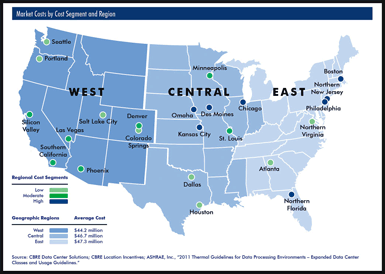Jobs vs. Capital Investment
The number-one goal of policymakers is to grow tax revenues. This is true at a city level up to the state legislative level. The most common driver of tax revenue growth is job creation. Thus, most elected leaders, reporters, and taxpayers often wonder why incentives are offered to companies building data centers. Data centers tend to be relatively low on employment. Typical headquarters, manufacturing, or shared service operations can have between 200 and 1,000 jobs on site. By comparison, the number of jobs at a typical data center can be anywhere between five and 30. A recurring criticism is, “Why give incentives to a data center that employs only 30 people when a state could be investing in a 500-job headquarters?”

Revenue at the state level:
- Sales taxes on construction materials
- Sales/use taxes on equipment purchases
- Sales taxes or franchise fees on power consumption
- Personal income taxes from construction and permanent jobs
- Unemployment taxes from construction and permanent
- Sales taxes on construction materials
- Sales/use taxes on equipment purchases
- Sales taxes or franchise fees on power consumption
- Local income taxes from construction and permanent jobs
- Real estate taxes on a newly constructed or renovated building
- Personal property taxes on computer servers and furniture
Which generates more revenue — a data center or a corporate headquarters?
CBRE conducted an economic and fiscal impact study on a $1 billion data center development. Based on a typical state/community’s tax structure as well as economic and demographic characteristics, a $1 billion data center could generate upward of $200 million in total tax revenues over a 10-year period of time, including the one-time construction phase and ongoing operations. This $200 million fiscal impact is equivalent to a corporate headquarters creating 1,700 jobs with a $130,000 average salary and making a $40 million capital investment. It should be noted these fiscal impact estimates are intended to be ballpark comparisons. Actual impacts will vary from state to state and community to community.
A state/community should be equally (if not more) motivated to recruit data center developments as it would any other typical economic development project. Incentivizing a 1,700-job corporate headquarters would have the same impact has incentivizing a $1 billion data center.
Lesson Learned
The impacts of data center development are real and long lasting. A state/community should be equally (if not more) motivated to recruit data center developments as it would any other typical economic development project. Incentivizing a 1,700-job corporate headquarters would have the same impact has incentivizing a $1 billion data center.
Data centers also have a significant positive impact on community development. They tend to require enhancements to infrastructure such as roads, water, sewer, and to a lesser extent power. This infrastructure development tends to support higher employment uses and, in some cases, accelerates employment growth that otherwise would not occur in the foreseeable future.
Although data centers tend to entail minimal job creation — generally in the 20- to 50-job range — this minimal job impact comes with minimal costs of services for roads and schools. Schools are not expected to experience much (if any) strain because of the lack of new students brought about by a data center development. Thus, overall, a data center can become a community’s single largest taxpayer.